Your cart is empty!
- Edition of 1000
- 96 pages / 70 colour plates
- Hardback
- 9.1 x 12.2 in / 23 x 31 cm
- Design: Scott King & Tom Etherington
- ISBN: 978-1-7395964-1-5
- Printed by EBS, Verona
- Signed
- Shipping / UK £2.50 / Europe £12.50 / Worldwide £22.50
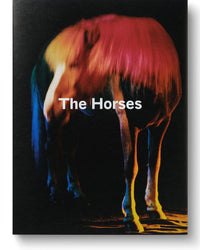
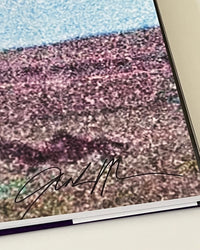
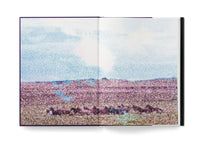
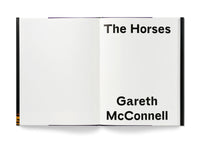
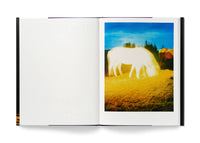
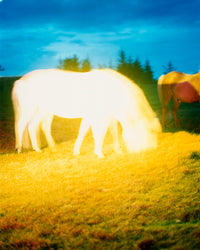
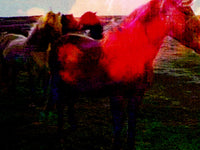
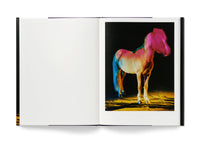
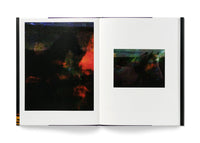
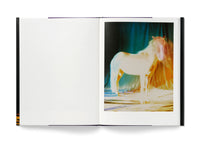
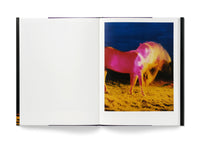
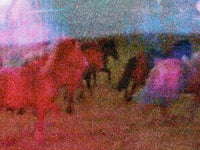
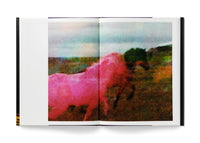
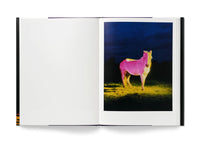
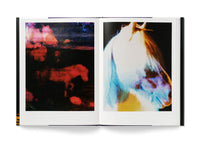
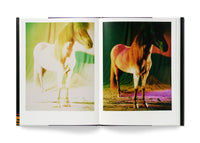
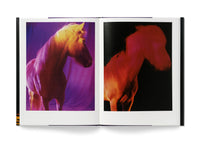
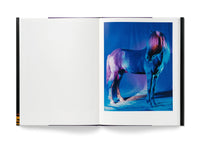
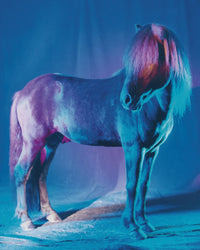
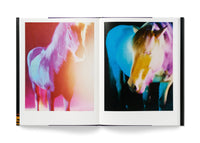
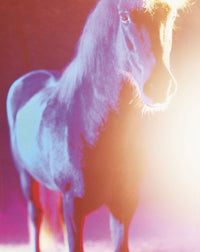
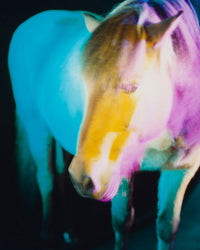
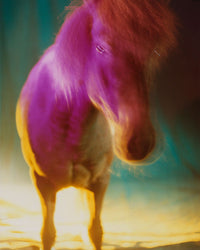
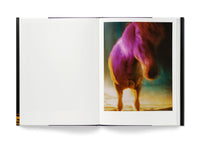
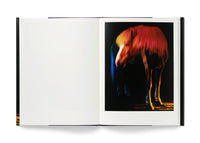
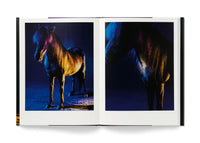
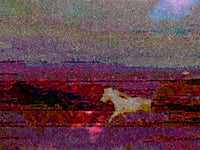
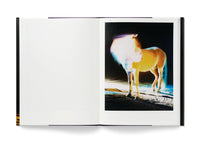
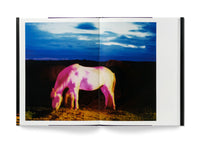
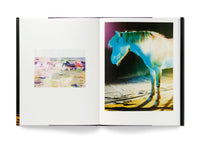
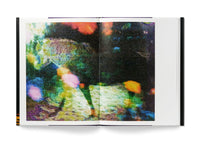
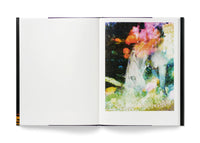
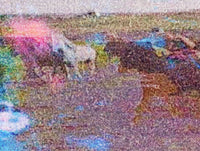
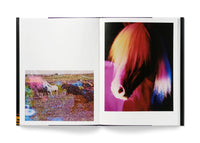
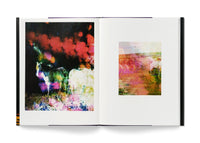
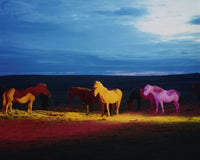
£40.00
_____
‘These fantastical Horses look like My Little Ponies on Mars'
Sam Anderson, The New York Times Magazine.
_____
'The Horses is a beautiful, candy-colored acid trip of a book.'
The Ten Best Photography Books of 2023
Jeff Campagna, Smithsonian Magazine
_____
‘He shines improbably glorious, cosmic lights on the horses, using colours like those associated with transformative mood experiences such as music and dance, drug use, or the bright sunlight that falls through the stained-glass window of cathedrals.’ Neal Brown, author of Tracey Emin (Modern Art series), Tate Publishing
_____
Gareth McConnell’s psychedelic photographs of Icelandic horses reimagine these animals not as symbols of control or nobility, but as electric, cosmic beings flickering between dream and hyperreality. Bathed in neon hues, they pulse with strange sentience, echoing art historical and literary references—from Franz Marc’s spiritual color theory to Edwin Muir’s apocalyptic steeds and the myth of Nietzsche’s Turin horse—each adding layers of meaning around freedom, chaos, and the unknowable. Set against Iceland’s mystical, volcanic landscape and resonating with the energy of interstellar ley lines, McConnell’s horses become more than animals; they are surreal messengers, blurring the boundaries between nature, myth, and the digital sublime.
'When Gareth McConnell was commissioned to photograph the wild horses of Iceland by the New York Times magazine last summer, there was a sense of apocalypse in the air. The news was dominated by the Russian invasion of Ukraine, and energy shortages and the climate emergency. McConnell didn’t know Iceland, or its singular horses, but he took with him, he says, a couple of personal reference points for the assignment.
One was Edwin Muir’s haunting poem The Horses, which begins: “Barely a twelvemonth after / The seven days war that put the world to sleep, / Late in the evening the strange horses came.” The other was pop shaman Bill Drummond’s belief that an interstellar ley line comes to Earth in the rifts and crags of Iceland (before later spiralling back underground outside the Cavern Club in Liverpool). McConnell was, at the very least, he told me last week, determined not to do a National Geographic set of pictures. The time and place seemed to demand something stranger, more unnatural.
Out in the “middle of nowhere” – or more precisely, Skeiðvellir in Iceland’s Suðurland region, about 50 miles east of Reykjavík – that sense of otherworldliness was only exaggerated. McConnell was struck by a feeling that the horses, “co-creators of our world up until the Industrial Revolution”, had been somehow cast adrift. It was as if, he says, as in Muir’s poem, an unnameable disaster had happened and the horses were part of the landscape of survival. The psychedelic effects of the pictures he took were mostly produced by playing around with torches and gels – “redundant technology”. This picture is included in a book he has made of the series. He toyed with the idea of calling the volume The Pink, Yellow and Blue Riders, but in the end, he borrowed Muir’s simpler title, The Horses – symbols, as the poet wrote, of “that long-lost archaic companionship”.'
Tim Adams, The Observer
_____
'Leaning towards the surreal and unexpected have always been at the heart of McConnell’s practice, which self-consciously refers to the history of the medium. The horse, in particular, is an important symbol in the history of art, evoking the equestrian portraits of George Stubbs, to Eadweard Muybridge’s late 19th-century stills-in-motion. “The horse is a poignant symbol,” McConnell adds. “Historically, they represented civilisation, power and status … but in this context we might think of the impending environmental catastrophe – the end of civilisation.”'
Lydia Figes, AnOther
_____
'McConnell has employed bold craft skills to make this series, which, by excluding models – humans – redistributes some species power. (McConnell has strong themes of misfit, misplaced, and outsider groups in his work.) He shines improbably glorious, cosmic lights on the horses, using colours like those associated with transformative mood experiences such as music and dance, drug use, or the bright sunlight that falls through the stained-glass window of cathedrals.
McConnell addresses ideas of separation caused, mostly, by human intervention. On occasion a horse is seen in what looks an understated indoor studio context, standing on stock floor coverings and before backdrops, unsaddled, and unbridled. The visual analogy with a beautiful human is striking – lights and shadows and colours are arranged to exquisite perfection, as they would be for a model in a sumptuous advertisement, the object of which is to persuade ownership.
With this series McConnell has launched the equivalent of a trillion-dollar campaign for extreme luxury goods, whose intention is not ownership, but to rewild. lt is an irony, of course, and part of our disgrace, that active human intervention for re-wilding is so necessary. Although McConnell’s campaign originates in the trans-hyphenating mythologies of Pegasus, unicorns, and centaurs, his target is prioritising the primary animal. In this way he gives value to what he says is a more ‘spiritual, expressive sphere,’ returning to horses their mystical absoluteness.'
Neal Brown
_____
'There is also a long tradition of horses being depicted in art, from neolithic cave paintings to Muybridge and the birth of cinema. Up until the industrial revolution, horses were vital to creating, and maintaining, society - helping us work the land and transport goods. It seems emblematic and timely to publish a book at this time, as we again enter an age of rapid change with technologies, such as AI, ushering in as yet unknown shifts in our society, art, and industry.'
Gareth McConnell, Coeval
_____
'I like the intervention of it. That it's very clearly a staged event. And it highlights the enchantment of the ordinary, the things we encounter daily but rarely appreciate. With my work, I'm trying to tune in to some kind of cosmic wonderment that's inherent in our surroundings, but that we pass by everyday and overlook.'
Gareth McConnell, EuroNews
_____
'I saw this as an opportunity to commune with our most ancient companion, one of the original subjects in art,” McConnell says. To him, the image of the horse symbolises technological progress while reminding us of “humankind’s urgent responsibility to repair its lost bond with nature.'
Gareth McConnell, Creative Review